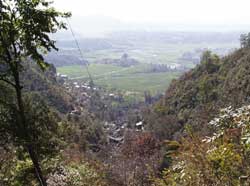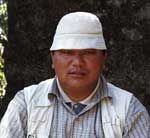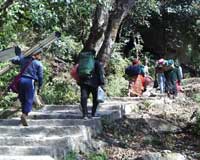 Stern-looking sentries check visitors' bags at the gate, a curious monkey peers down from a tree, and a couple of maroon-robed nuns wind their way up a dirt road to a nunnery on a hill in the heart of the Shivapuri National Park. Other than that it is all quiet, as always. The only indication that the protected area-until three weeks ago officially known as the Shivapuri Watershed and Wildlife Reserve-has just been designated Nepal's ninth national park is the yellow board being repainted by park officials.
Stern-looking sentries check visitors' bags at the gate, a curious monkey peers down from a tree, and a couple of maroon-robed nuns wind their way up a dirt road to a nunnery on a hill in the heart of the Shivapuri National Park. Other than that it is all quiet, as always. The only indication that the protected area-until three weeks ago officially known as the Shivapuri Watershed and Wildlife Reserve-has just been designated Nepal's ninth national park is the yellow board being repainted by park officials.
Shivapuri isn't \'just another national park'. "In terms of tourism the area has great potential," says tourism entrepreneur and former forester Karna Shakya. "It's probably the only protected area in the world less than a dozen kilometres from a teeming metropolis and international airport. And the biodiversity in there is remarkable by any standards."
And, of course, a quarter of the Valley's drinking water supply comes from here. About 30 million of the 200 million litres of water that flows out everyday from Shivapuri are tapped from numerous streams, including the Bagmati and Bishnumati, which originate in the Shivapuri hills. The water is collected into reservoirs and fed into pipelines to Kathmandu, and it is usually good, clean water compared with some of what passes for potable water in the capital.
But that is starting to change, just as it did about 25 years ago. "Most of the water originating from the headwaters in the Shivapuri watershed is clean and unpolluted, certain areas inhabited by villagers in Sundarijal are polluting the water source," says a park official. Back in the mid-1970s, Shivapuri was increasingly affected by urban sprawl and the degradation of its forests. Landslides and slips became common and the quality of drinking water deteriorated. From the mid-1970s to the early 1990s, all kinds of things have been tried for Shivapuri-it was first declared a protected watershed area, then a protected watershed and wildlife reserve. There were programs to encourage conservation farming, create alternative sources of livelihood, and raise awareness among local residents so the products of the forest, and the parts of them that people live in are used cautiously, rather than exploited as they have been in the past. But all programs were discontinued when donors and the government couldn't decide who should have control of them-donors wanted to decentralise, government wanted to retain its authority.  There will be stricter rules now that the area is a national park, and it will be easier to implement them firmly. If things go the way they should, people will be relocated to areas where the impact of their settlements on the fragile ecosystem and the watershed will be minimised and there will be more tourists enlarging the local economy. "It will take time, but once the park regulations come into force, we expect to increase park fees, promote eco-tourism, and start community projects, " says Bed Kumar Dhakal, assistant warden of this forest just 13 km north of the teeming Kathmandu metropolis.
There will be stricter rules now that the area is a national park, and it will be easier to implement them firmly. If things go the way they should, people will be relocated to areas where the impact of their settlements on the fragile ecosystem and the watershed will be minimised and there will be more tourists enlarging the local economy. "It will take time, but once the park regulations come into force, we expect to increase park fees, promote eco-tourism, and start community projects, " says Bed Kumar Dhakal, assistant warden of this forest just 13 km north of the teeming Kathmandu metropolis.
The trouble is, about 45,000 people depend directly or indirectly on Shivapuri for their livelihood, and residents of the area have seen so many programs fail, they are divided on this. Some are worried they will be forcefully relocated, and others aren't certain that the benefits, when they come, will help them directly. "Quite a few programs have come and gone. The people have benefited a little, but the benefits are negligible compared with local needs. There are few signs remaining of all that activity," says Nima Sherpa, chairman of the Sundarijal Village Development Committee. Pointing to a peach tree in bloom-the result of a project to help locals grow fruit-he adds, "What can one expect when you try distributing 50 apple saplings to 25 VDCs?"
Six of Sundarijal VDC's nine wards fall inside the protected area, and Sherpa's own house is one of approximately 400 households of Okhrepani and Mulkharka villages that were not relocated outside the watershed area when Shivapuri was declared a reserve. There have been plans, on and off, to relocate the settlements that remain inside the park boundaries, because human and agricultural waste (chemical fertilisers, insecticides etc) generated by the villages have polluted the water source in Sundarijal. Some reports even cite the presence of faecal matter in the water, and recommended that the local populace be relocated. "Nothing's happened so far. We are aware that Kathmandu's residents are drinking water that is polluted by waste generated here. But where else can we go," says Sherpa.
Troubled by marauding animals bent on destroying crops grown on 20 hectares of largely infertile land, and caught between the strict rules of the protected areas and the necessity to make ends meet, some are even not averse to shifting. "Given adequate compensation, we would be willing to move away, resettle in more fertile areas in the tarai," says a local, Narayan Shrestha. Now that the reserve has been designated a national park, he's concerned that regulations will be stricter and fines will be higher and that it will be harder for villagers to make ends meet. And even if relocation is back on the agenda, it is a matter of some debate whether the government can afford it. "At one time, the Shivapuri Development Committee worked out that it would cost Rs 120 million to shift the settlements over three years. But the Finance Ministry didn't have the money-today, it would probably cost Rs 150 million." Given that money is being diverted from development anyway, it seems unlikely this will happen any time soon.
The effects of the alternative, stricter enforcement and harsher penalties, could be offset by an increase in revenue from tourism. "But," says Sherpa, who runs a lodge inside the park, "the local people should be allowed to run the lodges and hotels, not some big company from Kathmandu." The VDC chairman says he has reason to be sceptical-he hasn't seen any of the income collected by the reserve go back to the community. "Sure, they might have built some resthouses and such, but what's the use of building unnecessary infrastructure when people need health care and education," he asks.
Dhakal shrugs off rumours of imminent relocation and that the government will take over the land immediately surrounding the area, which was designated a national park by an official notice published in the Royal Gazette on 18 February. "Of course now that this is a national park, there is some public concern that between 500 m and 1 km of land around the park will come under conservation protocol. That's in keeping with national park regulations. But nowhere in the regulations does it say that land ownership will be affected. It's basically gossip spread by estate brokers," says Dhakal.
More probable in the future, says the assistant warden, is that a buffer zone will be formed and there will be integrated community development programs, with local people voicing their opinions and concerns through user groups.
The long and short of Shivapuri
 Shivapuri is large and diverse-nine km north to south and 20-24 km east to west, ranging from an elevation of 1,000 m at the Likhu river in the northern valley, to 2,732 m high Shivapuri peak. Spread over 12 Village Development Committees of Kathmandu, nine VDCs of Nuwakot district, and two Sindhupalchowk VDCs, the Shivapuri National Park covers approximately 144 square km of land. It is the country's only park that lies entirely within Nepal's middle hills and there are plans to extend it towards Chandragiri and Pulchowki.
Shivapuri is large and diverse-nine km north to south and 20-24 km east to west, ranging from an elevation of 1,000 m at the Likhu river in the northern valley, to 2,732 m high Shivapuri peak. Spread over 12 Village Development Committees of Kathmandu, nine VDCs of Nuwakot district, and two Sindhupalchowk VDCs, the Shivapuri National Park covers approximately 144 square km of land. It is the country's only park that lies entirely within Nepal's middle hills and there are plans to extend it towards Chandragiri and Pulchowki.
The a 111 km boundary wall around the park, and Royal Nepal army guards protect the mixed hardwood forests of oak, pine, birch, rhododendron. The park area's rich biodiversity consists of endangered species like the sloth bear, black panther and the clouded leopard, 177 species of birds, including nine threatened species (including the paradise flycatcher) and 102 species of butterflies, even the rare Kaiser-i-Hind, and 129 species of mushrooms. Park brochures advise visitors not to hike alone on the fair weather road and foot trails inside the park, for fear of leopards and boars. A fog-free area because of the mountain winds blowing in from the Trisuli, Shivapuri was deemed in the Panchayat era a good place for a domestic airport, but that didn't materialise owing to a shortage of land.
For the culturally-minded, too, there's plenty here. Shivapuri has several religious sites for Hindus and Buddhists. On Nepali New Year, crowds from Kathmandu flock to Baghdwar and Bishnudwar, where the holy Hindu rivers Bagmati and Bishnumati originate. A two-hour hike brings you to Shivapuri peak, which offers a panoramic view of the Himalaya, and the main trekking route to Helambu passes through various Sherpa and Tamang villages in Shivapuri via Sundarijal.
Last fiscal year, the reserve collected about Rs 30 lakhs, 60 percent of which the government is entitled to. Nearly 24,000 people, mostly Nepalis, visited the park last year, almost double the number of people that visited seven years ago.


